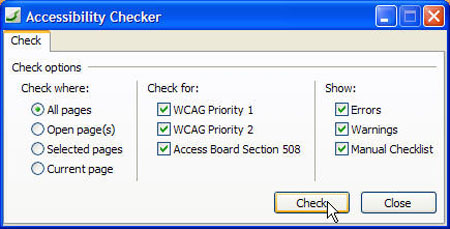Creating Accessible Web site designs means creating pages that can be viewed by anyone on the web, including those with disabilities who use special browsers to “read” pages to them. Designing accessible Web sites has the added advantage that it can boost your search engine rankings. Turns out the same rules for accessibility are good for SEO.
Depending on what kind of site you work on, you may be required to comply with accessibility standards because of Section 508. “This act requires access to electronic and information technology used by U.S. Federal agencies.”
Section 508 guidelines are similar to the WCAG guidelines and both are supported by Expression Web.
The WCAG guidelines have two priority settings. If your site doesn’t comply with Priority 1, the guidelines state, “One or more groups of users will find it impossible to access information.” Priority 1 issues include things like “alt” text, which provides a description of any non-text element on a page, such as a graphic banner or button.
If your site doesn’t comply with Priority 2, the guidelines state, “One or more groups of users might find it difficult to access information.” Priority 2 issue include things like, using rollovers when you could use CSS, or using an image map, when you could use separate links, which are more accessible.
To help ensure your site conforms to accessibility standards, you can run an accessibility report in Expression Web by following these instructions:
1. Choose Tools > Accessibility Reports
In the Accessibility Checker dialog box, specify whether you want to check All pages, Open pages, Selected pages, or the Current page. If you choose selected pages, click to highlight the pages you want to check in the Folder List task pane. In this example, I’ve selected All pages to check all of the pages in the root site folder at once.
Click to check the boxes next to WCAG Priority 1 and 2 to check for anything in your site that does not conform to those standards. Check Access Board Section 508 to check your site against those standards. You can check all three to ensure you site meets all of these standards at once.
In the final section of the Accessibility Checker dialog, check Errors and the report will identify any instances in your site defined as Errors under these guidelines. Check Warnings to include items that warrant warnings. Check Manual and Expression Web will produce a list of elements that it can not verify conclusively but could be errors and need to be check manually.

Whether your site is required to meet accessibility standards or not, it’s always good practice to make sure you site is accessible to all you visitors.
